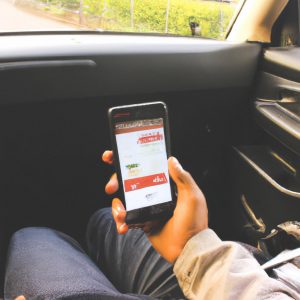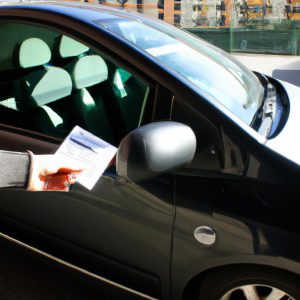Public Transit: Transportation Options in the Travel Directory

Public transportation plays a crucial role in providing efficient and sustainable means of travel for individuals within urban areas. With growing concerns about traffic congestion, environmental impact, and the need for cost-effective transport solutions, public transit systems have become an integral part of modern cities worldwide. For instance, imagine a bustling metropolis like New York City where millions of people rely on subways, buses, and trains to navigate through its labyrinthine streets. This case study highlights the significance of public transit as a viable transportation option and sets the stage for exploring various aspects of this domain.
In recent years, there has been an increased focus on developing comprehensive travel directories that cater to diverse transportation needs. These directories serve as valuable resources for both locals and tourists alike, offering information on different modes of public transit available in specific regions or cities. Such efforts aim to provide users with accessible and up-to-date details regarding routes, schedules, fares, and other essential elements pertaining to their journey. By having access to these directories, individuals can make informed decisions about which mode of public transportation best suits their requirements while considering factors such as convenience, affordability, accessibility, and environmental impact.
This article delves into the realm of public transit options presented by travel directories by examining their relevance in facilitating smooth commuting and enhancing the overall travel experience. Travel directories serve as a one-stop platform where users can find comprehensive information about various public transit options available in a specific area. These directories often include details such as bus routes, subway lines, train schedules, and even ferry services if applicable.
One key advantage of travel directories is that they provide real-time updates on route changes, delays, or disruptions in service. This allows commuters to plan their journeys more effectively and make necessary adjustments based on the latest information available. For instance, if there is a temporary closure of a subway line or a bus detour due to construction work, users can easily access this information through the directory and choose an alternative route accordingly.
Another significant benefit of travel directories is their ability to integrate different modes of transportation seamlessly. In many cities, commuters may need to switch between buses, subways, and trains during their journey. Travel directories enable users to navigate these connections efficiently by providing detailed transfer instructions and estimated travel times. By streamlining the process of switching between different modes of public transit, directories contribute to reducing commuting stress and increasing overall efficiency.
Furthermore, travel directories often feature additional useful information such as accessibility options for individuals with disabilities or special needs. They may highlight stations or stops equipped with elevators or ramps for wheelchair accessibility, helping users plan their trips accordingly. Additionally, some directories may incorporate user reviews and ratings for specific routes or services, allowing individuals to make informed decisions based on others’ experiences.
In conclusion, travel directories play a crucial role in facilitating smooth commuting and enhancing the overall travel experience by offering comprehensive information about public transit options. By providing real-time updates on routes and schedules, seamless integration of multiple modes of transportation, accessibility features for all users, and user-generated reviews and ratings, these directories empower individuals to make informed decisions about their journeys while ensuring convenience and efficiency in urban transportation systems
Benefits of Public Transit
Public Transit: Transportation Options in the Travel Directory
Benefits of Public Transit
Public transit, such as buses, trains, and trams, offers numerous benefits for individuals and communities. To illustrate this, imagine a bustling city with heavy traffic congestion during peak hours. In this scenario, public transit provides an effective solution by reducing the number of private vehicles on the road, thereby alleviating congestion and improving overall traffic flow.
One significant advantage of utilizing public transit is its positive impact on the environment. By opting for shared transportation options rather than relying solely on personal vehicles, individuals contribute to reduced carbon emissions and air pollution. This not only helps combat climate change but also enhances the quality of air we breathe. Furthermore, public transit systems often incorporate hybrid or electric vehicles into their fleets, further promoting sustainability.
In addition to environmental benefits, public transit can also lead to economic advantages for both individuals and society at large. Utilizing public transportation reduces individual expenses associated with owning a car – including fuel costs, maintenance fees, parking charges, and insurance premiums. Moreover, when more people choose public transit over private cars, it results in cost savings for governments that would otherwise need to invest heavily in expanding road infrastructure.
- Community Cohesion: Public transportation brings diverse groups of people together from all walks of life.
- Accessibility: It provides mobility options for those who may not have access to private vehicles.
- Reduced Stress: Avoiding traffic jams allows commuters to arrive at their destinations feeling less stressed.
- Improved Health: Walking or cycling to reach nearby bus stops or train stations promotes physical activity.
Furthermore, let us explore these emotional responses through a three-column table:
| Benefit | Description | Emotional Response |
|---|---|---|
| Community Cohesion | Interaction among people from different backgrounds strengthens communities | Sense of belonging |
| Accessibility | Ensuring transportation options are available to all, regardless of income | Equal opportunity |
| Reduced Stress | Avoiding the frustration and anxiety associated with traffic congestion | Peace of mind |
| Improved Health | Encouraging physical activity through walking or cycling | Enhanced well-being and fitness |
In summary, public transit systems offer a range of benefits that extend beyond individual convenience. From environmental sustainability and economic advantages to fostering community cohesion and promoting better health, utilizing public transportation is an effective way to address various societal challenges. In the subsequent section on “Types of Public Transit,” we will explore the various modes available in more detail.
Types of Public Transit
Public Transit: Transportation Options in the Travel Directory
Benefits of Public Transit (continued)
While public transit offers numerous advantages, it is important to explore the different types available. One such type is light rail systems, which are frequently used in urban areas for their efficiency and ability to transport large numbers of passengers. For instance, consider a hypothetical scenario where a city implements a new light rail system. This results in reduced traffic congestion, shorter commuting times, and improved air quality due to fewer private vehicles on the road.
To better understand the benefits of public transit, let us delve into some key aspects:
- Affordability: Public transportation often proves to be more economical than owning and maintaining a personal vehicle. By utilizing public transit services, individuals can save money on fuel costs, parking fees, and vehicle maintenance expenses.
- Environmental Sustainability: Public transit significantly reduces carbon emissions by minimizing the number of cars on the road. With each person who chooses public transit over driving alone, there is a collective effort towards combating climate change and promoting sustainability.
- Social Inclusion: Public transportation plays an essential role in fostering social inclusion by providing accessible transportation options for people with disabilities or limited mobility. It connects various communities within a city and enables equal access to education, employment opportunities, healthcare facilities, and recreational areas.
- Reduced Congestion: Efficient public transit networks alleviate traffic congestion by reducing the number of cars on busy roads during peak travel hours. Consequently, this leads to smoother traffic flow, quicker commutes for both drivers and transit users alike.
Emphasizing these points further underscores how public transit positively impacts society as a whole:
| Benefit | Description |
|---|---|
| Economic Saving | Reduces individual expenditure through lower transportation costs |
| Environmental Impact | Decreases pollution levels and contributes towards sustainable development |
| Accessibility | Enhances inclusivity by providing reliable transportation options for all individuals |
| Traffic Flow | Alleviates congestion and improves overall traffic conditions |
By recognizing the multifaceted advantages of public transit, we can strive towards creating a more sustainable and inclusive society. In the subsequent section about “How to Use Public Transit,” we will explore practical tips and guidelines for utilizing these transportation options effectively. Transitioning into this topic, it becomes evident that understanding the various types of public transit is an essential precursor to maximizing their benefits in our daily lives.
How to Use Public Transit
Public Transit: Transportation Options in the Travel Directory
Types of Public Transit
Now, let’s delve deeper into how to effectively use these transportation options. To illustrate this, consider a hypothetical scenario where Sarah, a tourist visiting an unfamiliar city, needs to navigate her way from the airport to her hotel using public transit.
To ensure a smooth journey when using public transit, there are several key steps that can be followed:
-
Research and Plan Ahead:
- Determine the most convenient routes and schedules based on your destination.
- Check if any specific fares or tickets are required for certain modes of transport.
- Look up maps and timetables online or download relevant apps to stay informed while on the go.
-
Purchase Tickets in Advance:
- Many cities offer pre-loaded cards or digital payment systems that simplify fare payments.
- Buying tickets ahead of time not only saves you time but also ensures you have valid credentials before boarding.
-
Follow Proper Etiquette:
- Respect fellow passengers by offering seats to those who need them more.
- Keep conversations at a reasonable volume and avoid playing music without headphones.
- Be mindful of personal space and keep belongings close by to prevent inconveniencing others.
-
Stay Alert and Aware:
- Pay attention to announcements regarding upcoming stops or route changes.
- Remain cautious of your surroundings, especially during crowded periods or late-night travels.
The following table provides a summary comparison between different types of public transit options based on factors such as cost, availability, convenience, and environmental impact:
| Mode of Transport | Cost (per trip) | Availability | Convenience | Environmental Impact |
|---|---|---|---|---|
| Bus | $1-$5 | Frequent | Moderate | Low |
| Subway | $2-$7 | Frequent | High | Low |
| Train | $5-$15 | Varies | High | Moderate |
| Tram | $1-$4 | Limited | Moderate | Low |
By following these steps and considering the factors mentioned above, travelers like Sarah can make informed decisions when utilizing public transit. In our next section on Public Transit Safety Tips, we will explore how to ensure a secure and worry-free experience during your travels.
Public Transit Safety Tips
Now that you know how to effectively use public transit, let’s focus on some essential safety tips to keep in mind while traveling.
Public Transit Safety Tips
Having learned how to use public transit effectively, it is essential to prioritize safety during your journeys. By following a few simple guidelines and being aware of potential risks, you can ensure a secure and comfortable experience while utilizing public transportation.
To illustrate the importance of adhering to safety measures, let’s consider an example. Imagine Sarah, a frequent public transit user who always takes precautions when traveling. One evening, Sarah exits a bus at her usual stop but notices a suspicious individual lingering nearby. Instead of ignoring her instincts, she decides to wait inside the bus shelter until someone else arrives or calls for assistance. By trusting her gut feeling and taking appropriate action, Sarah successfully avoids any potential danger.
When using public transit systems, keep these safety tips in mind:
- Be vigilant and aware of your surroundings at all times.
- Avoid displaying valuable items such as expensive jewelry or electronics.
- Keep personal belongings close to you and avoid leaving them unattended.
- If you feel uncomfortable or unsafe on board a vehicle or at a station/stop, trust your intuition and take necessary steps to protect yourself.
By incorporating these practices into your routine, you can minimize the risk of encountering unsafe situations while using public transportation.
- Stay safe by staying alert
- Protect your valuables
- Secure your belongings
- Trust your instincts
In addition to applying general safety principles, it is also helpful to be familiar with specific safety features offered by different transport providers. The table below highlights some common safety measures implemented in various types of public transit:
| Public Transportation Mode | Safety Features |
|---|---|
| Buses | CCTV cameras |
| Trains | Emergency call buttons |
| Subways | Well-lit platforms |
| Ferries | Life jackets available |
These are just a few examples; each mode of transportation may offer additional safety features. Being aware of these provisions can further enhance your sense of security when utilizing public transit.
By following these safety tips and being mindful of the security measures available, you can confidently navigate public transportation systems. In the upcoming section on “Public Transit Etiquette,” we will explore how to ensure a positive experience for both yourself and fellow passengers while using public transit networks.
Public Transit Etiquette
In our exploration of public transit, we have already discussed important safety tips to keep in mind while using these transportation systems. Now, let us delve into the realm of public transit etiquette. To illustrate the significance of adhering to proper conduct, consider a hypothetical scenario where an individual is traveling during peak hours on a crowded subway train. By practicing good etiquette, such as offering their seat to someone in need or keeping personal belongings close by and not obstructing pathways, this person contributes to a more pleasant and efficient commuting experience for all passengers.
To ensure that everyone can enjoy their journey on public transit, it is essential to be mindful of certain guidelines:
- Respect Personal Space: Maintain appropriate physical distance from fellow commuters whenever possible.
- Be Mindful of Noise Levels: Keep conversations at a reasonable volume and avoid playing music without headphones.
- Follow Seating Etiquette: Offer seats designated for elderly individuals, pregnant women, or people with disabilities when needed.
- Practice Good Hygiene: Cover your mouth when coughing or sneezing and make use of hand sanitizers if available.
Emphasizing the impact of positive behavior on public transit usage further highlights its importance. Consider the following table showcasing how different actions affect overall passenger experiences:
| Behavior | Impact |
|---|---|
| Offering Seats | Creates a welcoming environment |
| Keeping Conversations Quiet | Allows others to concentrate or rest |
| Using Headphones | Prevents disturbance |
| Maintaining Cleanliness | Enhances comfort and reduces potential health risks |
By demonstrating respect for one another’s needs and comfort through adherence to proper etiquette, we contribute positively towards fostering a sense of community among commuters.
Looking ahead towards the future of public transit, advancements are being made continuously to improve accessibility, efficiency, and sustainability. In our subsequent section about “The Future of Public Transit,” we will explore the exciting developments and innovations that hold promise for an even more convenient and environmentally friendly transportation system.
Future of Public Transit
Transition from Previous Section H2: Public Transit Etiquette
In order to fully appreciate and navigate public transit, it is crucial to familiarize oneself with the various transportation options available. Understanding these options not only enhances one’s travel experience but also promotes efficient and sustainable mobility within cities. This section explores different modes of public transportation commonly found in urban areas.
Case Study: The City of Metropolis
To illustrate the diverse range of transportation options available, let us consider the hypothetical case study of Metropolis—a bustling metropolis renowned for its well-developed public transit system. In this city, residents and visitors alike have access to a wide array of transportation choices that cater to their varying needs and preferences.
Metropolis offers an extensive network of buses that connect every corner of the city, providing affordable and accessible transport for individuals commuting across different neighborhoods. Additionally, the city boasts a comprehensive subway system consisting of multiple lines that efficiently transport large volumes of passengers during peak hours.
To further enhance connectivity, Metropolis has implemented bike-sharing programs throughout the city. These initiatives provide convenient alternatives for short-distance travel while promoting eco-friendly practices among citizens. Furthermore, robust pedestrian infrastructure ensures safe and comfortable walking experiences for those who prefer exploring the city on foot.
The availability of multiple transportation options offers numerous benefits to both residents and tourists visiting Metropolis:
- Increased accessibility for individuals with limited mobility.
- Reduced traffic congestion by encouraging car-free travel.
- Improved air quality through decreased reliance on private vehicles.
- Enhanced overall sustainability by promoting environmentally friendly modes of transport.
Below is a table highlighting some key attributes associated with each mode of public transit in Metropolis:
| Mode | Key Attributes |
|---|---|
| Buses | – Extensive coverage area- Affordable fares- Flexible schedules |
| Subway | – Fast and efficient- High passenger capacity- Reduced commute times |
| Bike-sharing | – Convenient short-distance travel- Promotes environmental sustainability- Encourages physical activity |
| Pedestrian Infrastructure | – Safe and comfortable walking experiences- Accessible sidewalks and crosswalks- Promotes urban exploration |
By providing a range of transportation options, Metropolis ensures that its residents and visitors can choose the mode that best suits their needs while collectively contributing to a more sustainable and efficient city.
In summary, understanding the various modes of public transit available in a given location is essential for effective travel planning. Cities like Metropolis serve as examples of how multiple transport options can create an interconnected network that promotes accessibility, reduces congestion, improves air quality, and fosters overall urban sustainability. Whether it’s buses, subways, bike-sharing programs, or pedestrian-friendly infrastructure, each option contributes to a holistic approach towards efficient public transportation systems.








